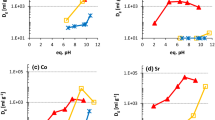Abstract
Composite sorbents based on the nanoparticles of NiO, NiO–TiO2 and ZrO2–TiO2 embedded in polyacrylonitrile were chosen for the treatment of spent decontamination solutions based on citric acid. Active oxidic materials were prepared by photoinduced synthesis (NiO, NiO–TiO2) or hydrolytic method (ZrO2–TiO2). Weight distribution ratios for radionuclides 241Am, 60Co, 137Cs and 90Sr/90Y were investigated during the experiments performed in pH range 2–12. High sorption capacities up to 9 mmol g–1 for 137Cs were found by sorption isotherm experiments. Dynamic experiments were carried out with simulated spent decontamination solutions containing citric acid. Elution of > 85% radionuclide waste with mineral acids or complexing agents was in 5–6 times lower volume compared to treated spent solution.






Similar content being viewed by others
References
Brynych V, Pospěchová J, Procházková L, Čuba V, Szatmáry L (2022) Sorption of Cs(I), Sr(II) and Eu(III) on Modified Nickel Oxide. Nanocon 2014 conference proceedings. http://nanocon2014.tanger.cz/files/proceedings/20/reports/3335.pdf. Accessed 17 Mar 2022
Ai L, Zeng Y (2012) Hierarchical porous NiO architectures as highly recyclable adsorbents for effective removal of organic dye from aqueous solution. Chem Eng J 215–216:269–278
Engates KE, Shipley HJ (2011) Adsorption of Pb, Cd, Cu, Zn, and Ni to titanium dioxide nanoparticles: effect of particle size, solid concentration, and exhaustion. Environ Sci Pollut Res Int 3:386–395
Mahmood T, Saddique M, Naeem A (2011) Cation exchange removal of Cd from aqueous solution by NiO. J Hazard Mater 2–3:824–828
Wołowicz A, Wawrzkiewicz M, Hubicki Z, Siwińska-Ciesielczyk K, Kubiak A, Jesionowski T (2022) Enhanced removal of vanadium(V) from acidic streams using binary oxide systems of TiO2–ZrO2 and TiO2–ZnO type. Sep Purif Technol. https://doi.org/10.1016/j.seppur.2021.119916
Dekontaminace radioaktivních látek, Bojový řád jednotek požární ochrany - taktické postupy zásahu. http://www.hzscr.cz/soubor/l9-dekontaminace-ral-pdf.aspx. Accessed 17 Mar 2022
Fišera O, Kareš J, Procházková L, Čuba V, Popovich K, Bárta J (2018) Sorption properties of selected oxidic nanoparticles for the treatment of spent decontamination solutions based on citric acid. J Radioanal Nucl Chem 318:2443–2448. https://doi.org/10.1007/s10967-018-6303-5
Neppolian B, Wang Q, Yamashita H, Choi H (2007) Synthesis and characterization of TiO2–ZrO2 binary oxide semiconductor nanoparticles: application and interparticle electron transfer process. Appl Catal A 333:264–271
Čuba V, Procházková L, Bárta J, Vondrášková A, Pavelková T, Mihóková E, Jarý V, Nikl M (2014) UV radiation: a promising tool in the synthesis of multicomponent nano-oxides. J Nanopart Res. https://doi.org/10.1007/s11051-014-2686-6
Bárta J, Prouzová Procházková L, Škodová M, Děcká K, Popovich K, Janoušková Pavelková T, Beck P, Čuba V (2022) Advanced photochemical processes for the manufacture of nanopowders: an evaluation of long-term pilot plant operation. React Chem Eng 7:968–977
Šebesta F (1997) Composite sorbents of inorganic ion-exchangers and polyacrylonitrile binding matrix. I. Methods of modification of properties of inorganic ion-exchangers for application in column packed beds. J Radioanal Nucl Chem 220:77–88
Fišera O, Kareš J, Procházková L, Čuba V, Vlk M, Kozempel J, Fialová K, Palušák M (2020) Device and method for the separating radionuclides from rinsing solutions (in Czech). CZ Patent No. 308654. Industrial Property Office of the Czech Republic. https://isdv.upv.cz/doc/FullFiles/Patents/FullDocuments/308/308654.pdf. Accessed 17 Mar 2022
Kubiak A, Siwińska-Ciesielczyk K, Jesionowski T (2018) Titania-based hybrid materials with ZnO, ZrO2 and MoS2: a review. Materials (Basel) 11:2295. https://doi.org/10.3390/ma11112295
Mahmood T, Saddique MT, Naeem A, Westerhoff P, Mustafa S, Alum A (2011) Comparison of different methods for the point of zero charge determination of NiO. Ind Eng Chem Res 50:10017–10023
Pospěchová J, Brynych V, Štengl V, Tolasz J, Langecker JH, Bubeníková M, Szatmáry L (2015) Polysaccharide biopolymers modified with titanium or nickel nanoparticles for removal of radionuclides from aqueous solutions. J Radioanal Nucl Chem. https://doi.org/10.1007/s10967-015-4414-9
Ren X, Yang S, Tan X, Chen Ch, Wang X (2012) Investigation of radionuclide 60Co(II) binding to TiO2 by batch technique, surface complexation model and DFT calculations. Sci China Chem. https://doi.org/10.1007/s11426-012-4694-7
Kosmulski M (2002) The significance of the difference in the point of zero charge between rutile and anatase. Adv Colloid Interface 99(3):255–264. https://doi.org/10.1016/S0001-8686(02)00080-5
Kosmulski M (2002) The significance of the points of zero charge of zirconium (Hydr)oxide reported in the literature. J Disper Sci Technol 23(4):529–538. https://doi.org/10.1081/DIS-120014021
DOWEX 88 MB. Product information. Dow Chemical Company. https://www.lenntech.com/Data-sheets/Dowex%2088%20MB%20(H).pdf. Accessed 25 May 2022
AMBERJET 1000 H. Product data sheet. Rohm and Haas Company. https://www.lenntech.com/Data-sheets/Amberjet-1000-H-L.pdf. Accessed 25 May 2022
Naushad M (2009) Inorganic and composite ion exchange materials and their applications. Ion Exch Lett 2:1–14. http://iel.vscht.cz/articles/1803-4039-02-0001.pdf. Accessed 25 May 2022
Acknowledgements
This project was supported by the Ministry of Interior of the Czech Republic under contract No. VI20172020106.
Author information
Authors and Affiliations
Corresponding author
Ethics declarations
Conflict of interest
The authors declare no conflict of interest.
Additional information
Publisher's Note
Springer Nature remains neutral with regard to jurisdictional claims in published maps and institutional affiliations.
Rights and permissions
Springer Nature or its licensor holds exclusive rights to this article under a publishing agreement with the author(s) or other rightsholder(s); author self-archiving of the accepted manuscript version of this article is solely governed by the terms of such publishing agreement and applicable law.
About this article
Cite this article
Fišera, O., Kareš, J., Prouzová Procházková, L. et al. Treatment of spent decontamination solutions based on citric acid with composite polyacrylonitrile: transient metal oxidic nanoparticles sorbents. J Radioanal Nucl Chem 332, 1541–1547 (2023). https://doi.org/10.1007/s10967-022-08598-2
Accepted:
Published:
Issue Date:
DOI: https://doi.org/10.1007/s10967-022-08598-2




